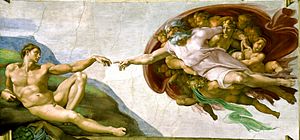Italian Renaissance facts for kids

The Italian Renaissance was a very important time in Europe. It was a period of big changes and amazing achievements. This exciting era began in Italy during the 14th century. It slowly changed Europe from the Middle Ages to the Early Modern period.
The word "Renaissance" comes from a French word meaning "Rebirth." This time was all about a renewed interest in the ideas and art of ancient Greece and Rome. It started with a focus on Humanism, which is about human values and achievements. But it quickly spread to many other areas. These included science, religion, art, and exploration.
During the Renaissance, many famous things happened. William Shakespeare wrote his amazing plays. Leonardo da Vinci painted the famous Mona Lisa. Martin Luther started a new religious movement. Christopher Columbus discovered the Americas. And Johannes Gutenberg brought printing to Europe. The "rebirth" that started in Italy slowly spread to Northern Europe. As it moved, it also influenced religious changes.
Contents
What Was the Renaissance?
The Renaissance was a time when people looked back at the ancient Greek and Roman cultures. They found new inspiration in their art, philosophy, and knowledge. This led to new ways of thinking and creating. It was a bridge between the old ways of the Middle Ages and the modern world.
A Time of New Ideas
People started to question old ideas and explore new ones. This led to big advancements in many fields.
- Art: Artists like Leonardo da Vinci and Michelangelo created masterpieces. They used new techniques like perspective.
- Science: Thinkers began to observe the world more closely. They used experiments to understand how things worked.
- Exploration: Brave explorers set sail to discover new lands. They expanded the known world.
- Literature: Writers created new forms of poetry and stories. They often wrote in their local languages.
Why Did It Start in Italy?
Italy was the perfect place for the Renaissance to begin. It had several reasons that helped this cultural explosion.
Wealthy City-States
Italy was made up of many rich city-states. Cities like Florence, Venice, and Rome were very wealthy. This wealth came from trade and banking. Rich families and rulers could afford to support artists and thinkers. They became patrons of the arts.
Links to Ancient Rome
Italy was the home of the ancient Roman Empire. Many ruins and old texts were still there. This made it easier for people to rediscover classical ideas. Scholars studied ancient Latin and Greek writings. They learned about philosophy, history, and science from the past.
New Ways of Thinking
A new way of thinking called Humanism became popular. Humanists believed in the value and potential of humans. They focused on human achievements and education. This was different from the Middle Ages, which often focused more on the afterlife. Humanists encouraged people to learn, explore, and create.
Famous People of the Italian Renaissance
Many incredible people lived during this time. They changed art, science, and how people thought.
Artists and Sculptors
- Leonardo da Vinci: A true "Renaissance Man." He was a painter, sculptor, musician, scientist, inventor, and more. His most famous works include the Mona Lisa and The Last Supper.
- Michelangelo: A master sculptor, painter, and architect. He created the famous David statue. He also painted the ceiling of the Sistine Chapel in Rome.
- Raphael: Known for his beautiful and harmonious paintings. He created many famous Madonnas and large fresco works in the Vatican.
Writers and Thinkers
- Dante Alighieri: An early Renaissance writer. He wrote Divine Comedy, a long poem about a journey through heaven and hell.
- Petrarch: Often called the "Father of Humanism." He was a poet and scholar who helped bring back interest in classical texts.
- Niccolò Machiavelli: A political writer. He wrote The Prince, a book about how rulers can gain and keep power.
Scientists and Explorers
- Galileo Galilei: A key figure in the scientific revolution. He made important discoveries about astronomy and physics. He improved the telescope.
- Christopher Columbus: An Italian explorer who sailed across the Atlantic Ocean. He reached the Americas in 1492. This opened up new trade routes and changed world history.
How the Renaissance Spread
The ideas and styles of the Italian Renaissance slowly moved across Europe. This happened through trade, travel, and the new invention of printing.
The Printing Press
Johannes Gutenberg invented the printing press in the mid-1400s. This made books much cheaper and easier to produce. Ideas from Italy could now spread quickly to other countries. More people could read and learn about the new ways of thinking.
Cultural Exchange
Artists, scholars, and merchants traveled between Italy and other parts of Europe. They shared ideas and techniques. This helped the Renaissance influence art, architecture, and education in places like France, England, and the Netherlands.
Images for kids
-
Portrait of Dante Alighieri by Cristofano dell'Altissimo, Uffizi Gallery Florence
-
Pandolfo Malatesta (1417–1468), lord of Rimini, by Piero della Francesca. Malatesta was a capable condottiere, following the tradition of his family. He was hired by the Venetians to fight against the Turks (unsuccessfully) in 1465, and was the patron of Leone Battista Alberti, whose Tempio Malatestiano at Rimini is one of the first entirely classical buildings of the Renaissance.
-
Portrait of Cosimo de' Medici by Jacopo Pontormo
-
Leonardo da Vinci, Italian Renaissance Man
-
Niccolò Machiavelli (1469–1527), the author of The Prince and prototypical Renaissance man. Detail from a portrait by Santi di Tito.
-
Petrarch, from the Cycle of Famous Men and Women. ca. 1450. Detached fresco. 247 cm × 153 cm (97.24 in × 60.24 in). Galleria degli Uffizi, Florence, Italy. Artist: Andrea di Bartolo di Bargilla (ca. 1423–1457).
-
Detail of The Last Judgment, 1536–1541, by Michelangelo
-
Bramante's Tempietto in San Pietro in Montorio, Rome, 1502
-
Claudio Monteverdi by Bernardo Strozzi (c. 1630)
See also
 In Spanish: Renacimiento italiano para niños
In Spanish: Renacimiento italiano para niños










